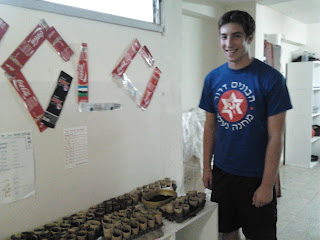What does an average day on Boneh look like?
Today, Sarah and Yoav's chanichim woke up early to go to work. The chanchim work in many different places on kibbutz, including a cheese shop, the children's houses, and the chader ochel (dining hall). Below, a chanich who works with the kibbutz handy man.
Carmi and Yael's chanichim spent the morning in shiurim (classes). This week's theme is Early Zionist Thought, and the chanichim spent the morning reading Zionist thinkers such as Theodor Herzl, AD Gordon, Moses Hess, and Leo Pinsker. They focused on the thoughts and ideas of Jews at the end of the 19th century, facing the tide of European nationalism and questions about the Jewish future. They were also encouraged to ask whether or not the reasons for the Jewish state are the same today as they were then. Does the Jewish state exist as more than a safe haven? What special characteristics does being Jewish have in a Jewish state? What are the possibilities of Jewish national independence? After work and shiurim, the chanichim went to the chader ochel for lunch.
After lunch and a break, the chanichim had Hadracha (Leadership Course) in their kvutzot.
Here to tell us about it is Doron Shore, a Workshop 62 participant.
"We learned about imagination, and how important and valuable it can be in developing kids' minds. We talked about machaneh as a unique place where we as madrichim, and also the chanichim, have the power to create whatever environment we want, and how during the year, chanichim do not have access to this type of experience, so what we as madrichim try to do is facilitate a positive atmosphere where kids feel comfortable with creation and we instill that confidence so kids can carry that outside of machaneh. We don't want chanichim to see machaneh as the only place where they can create, we want them to learn about themselves and take that confidence out into the world. To put this idea into practice, we split up into small groups and each received different parts of the day at machaneh (ex: lunch, mifkad boker, etc). We had to take an every day activity and make it special. My group had lunch, and we made it into a picnic, family-reunion style. Everyone got characters, and acted that way for the whole meal. Personally, hadracha has been the most thought-provoking part of Boneh because it feels so immediate. As a madrich last year, and looking forward to next year, it feels very applicable."
Below are pictures from Hadracha.
After Hadracha, the chanichim spent time in their Tzvatim. Tzvatim are a way for the chanichim to take responsibility over different aspects of Boneh. Responsibilities are divided between each tzevet (staff group), which is made up of 4-6 chanichim from both kvutzot. Some different tzvatim are Cleaning, Food and Budgeting, Holidays, Tochnit Erev (evening program) and Education and Current Events. In addition to the responsibilities given to them by their madrichim, the chanichim also decided to form two additional tzvatim, Gardening and Connection to the Kibbutz. Pictured below are sprouting seeds being prepared for the garden.
After tzevet planning time, the chanichim returned to the kibbutz chader ochel for dinner. All in all, a very full day. But still, plenty of time for shesh besh.







No comments:
Post a Comment